MAVCOR Journal is an open access born-digital, double blind peer-reviewed journal dedicated to promoting conversation about material and visual cultures of religion. Published by the Center for the Study of Material and Visual Cultures of Religion at Yale University and reviewed by members of our distinguished Editorial Board and other experts, MAVCOR Journal encourages contributors to think deeply about the objects, performances, sounds, and digital experiences that have framed and continue to frame human engagement with religion broadly understood across diverse cultures, regions, traditions, and historical periods.
A special issue curated by Kati Curts and Alex Kaloyanides
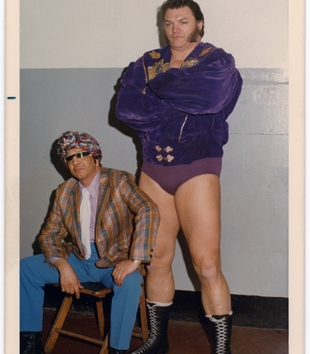 The Mormon Heel
The Mormon Heel
Don Leo Jonathan was born 1931 to a Mormon family in Utah. During his professional wrestling career, Don Leo capitalized on certain anti-Mormon prejudices during a period of Mormonism’s erstwhile mainstreaming and clean-cut imagination in American culture, often performing as the "heel," or villain.
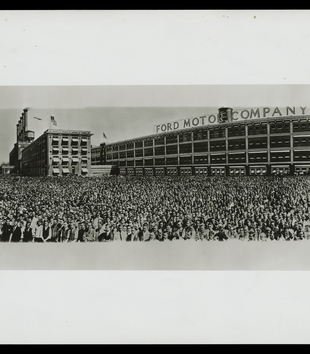 Relics and Rubber
Relics and Rubber
In 1929, Henry Ford opened the Henry Ford Museum. That same year Ford Motor Company set ablaze vast swaths of rainforest in Brazil to clear land for Fordlandia, one of Ford’s rubber plantations. In Ford’s “progressive” trail across the Americas and in pictured masses arrayed outside Ford’s plants, we glimpse material economies of religion christened as political economy and mass produced in Ford’s name.
A special issue guest edited by Kambiz GhaneaBassiri and Anna Bigelow.
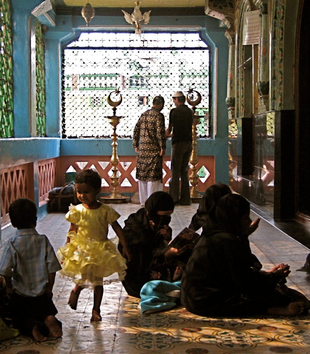 Introduction to the Special Issue: Material Islam
Introduction to the Special Issue: Material Islam
Anna Bigelow and Kambiz GhaneaBassiri introduce this special issue of MAVCOR Journal devoted to Material Islam. It explores devotional objects, the Islamic sensorium, the book as a material object, the Muslim body, and the various roles of the mosque as a social, political, and spiritual space. Taken together, its varied essays demonstrate an incredibly wide-ranging, rich, and exciting arena of study.
 In Conversation with Christiane Gruber on Material Islamic Studies
In Conversation with Christiane Gruber on Material Islamic Studies
Kambiz GhaneaBassiri and Anna Bigelow speak with Christiane Gruber about changes and growth in field of Material Islam, new arenas of inquiry, and their hopes for further interdisciplinary scholarship.
 Ablution Socks: The Logic of Market Capitalism and Its Limits
Ablution Socks: The Logic of Market Capitalism and Its Limits
The marketing of “wudhu socks" provides an interesting window onto how the forces of consumer capitalism in twenty-first-century America are brought to bear on a centuries-old hermeneutical, legal, and theological tradition in Islam that has long conceptualized purity through embodiment and objects.
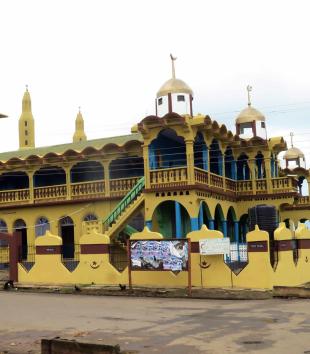 The Transcontinental Genealogy of the Afro-Brazilian Mosque
The Transcontinental Genealogy of the Afro-Brazilian Mosque
This article examines the genealogy of Afro-Brazilian mosques, answering some of the most immediate and puzzling questions that they force all who see them to ask. The answers to these questions demonstrate the fluidity of categories such as European, African, Islamic, and Christian, and how West African Muslims effectively drew on an architectural vocabulary with connections to three continents to forge an emergent cosmopolitan identity.
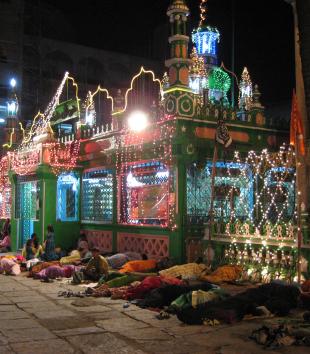 Senses of Belonging: Materiality, Embodiment, and Attunement at Sufi Shrines in India
In exploring the multiple modalities of Muslim belonging and unbelonging in India, the arenas in which Muslims and non-Muslims interact, especially at shared holy places, are extremely illuminating locales. This essay explores the ways in which material and somatic forms of interreligious encounter at a Sufi dargah (درگاہ), or tomb shrine, in Bengalaru (Bangalore) exemplify everyday as well as spectacular practices of shared piety that also reimagine the possibility of collective belonging in a time of precarity.
Senses of Belonging: Materiality, Embodiment, and Attunement at Sufi Shrines in India
In exploring the multiple modalities of Muslim belonging and unbelonging in India, the arenas in which Muslims and non-Muslims interact, especially at shared holy places, are extremely illuminating locales. This essay explores the ways in which material and somatic forms of interreligious encounter at a Sufi dargah (درگاہ), or tomb shrine, in Bengalaru (Bangalore) exemplify everyday as well as spectacular practices of shared piety that also reimagine the possibility of collective belonging in a time of precarity.
 Bībī kā ʿAlam
Bībī kā ʿAlam
The Bībī kā ʿalam, as it is popularly known, occupies a special, sacred class of ʿalams for the Hyderabadi Shiʿa. Containing Fatimah’s funerary plank, is a reliquary ʿalam and, while Hyderabad is distinctive for the extraordinary number of relics it possesses that are associated with the Imams and Ahl-e Bait, very few connect to Shiʿi women saints.
 A tenth-century Islamic manuscript from Kairouan, Tunisia
A tenth-century Islamic manuscript from Kairouan, Tunisia
A parchment bifolio from the Kairouan collection presents a mystery. But like pottery in an archeological dig, this fragment is in situ, and clues to the identity of the author, the text, and the community of scholars that wrote and preserved it, are found in the rich context of this unique collection. Together, these manuscripts bear witness to a fascinating history of literary and cultural production, not only in North Africa, but in the broader Islamic world of the ninth and tenth century.
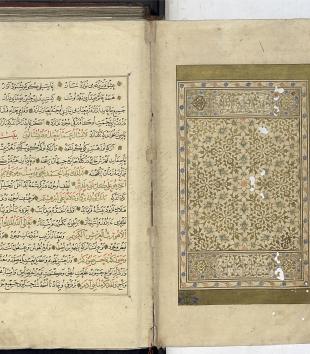 Adorning the King of Islam: Weaving and Unraveling History in Astarabadi’s Feasting and Fighting
Adorning the King of Islam: Weaving and Unraveling History in Astarabadi’s Feasting and Fighting
This article traces a fourteenth-century Persian history from Anatolia, Bazm wa Razm (Feasting and Fighting), written by ʿAzīz al-Dīn Astarābādī, from its presentation copy to its various recensions down to the modern period, examining how each era visually refigures this textual manifestation of its original patron, Burhān al-Dīn Aḥmad (r. 783-800 AH/1381-1398 CE), for a new purpose.
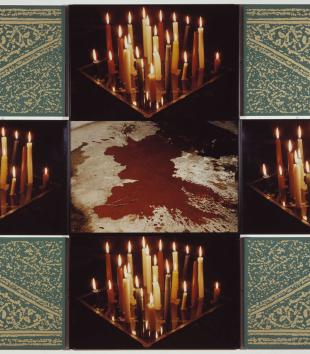 Rasheed Araeen’s Bismullah
Rasheed Araeen’s Bismullah
Rasheed Araeen’s Bismullah is noteworthy as the first work by the Karachi-born, London-based artist to enter the collection of Britain’s Tate Gallery in 1995. Bismullah deploys strategies of juxtaposition, disjunction, and doubling to combine visual imagery that references religion, empire, art history, and the artist’s personal biography. Through its montage tactics Bismullah not only maps the binaries of self and other that structure colonial discourse within and beyond the artistic field, but also recontextualizes these signifiers.
 Hikmet Barutçugil's Hüdayi Yolu
Hikmet Barutçugil's Hüdayi Yolu
Hüdayi Yolu represents a modern artist’s loving depiction of his hometown and neighborhood, an homage to a local Sufi saint, the romanticized communal memory of Istanbul as an Ottoman metropolis, and Barutçugil’s approach to “Sufi” art.
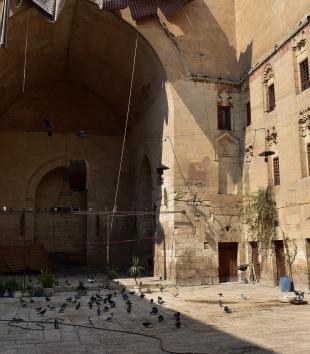 On the Material and Social Conditions of Khalwa in Medieval Sufism
On the Material and Social Conditions of Khalwa in Medieval Sufism
Ubiquitous across the medieval Islamic world, khalwa is the practice of self-isolation, typically in a small cell, in order to focus on pious devotions. This article offers one possible approach to theorizing the heterogenous elements of khalwa coherently by insisting that we take the material and the social as seriously as we do the human and the spiritual.
 Ayat Al Kursi Round
Ayat Al Kursi Round
Crowned by the word “Allah,” a dense piece of Arabic calligraphy carved out of stainless steel wraps around an embellished center. The text is the ayat al-kursī, or “The Throne Verse,” a portion of the Qur’an (2:256) often recited before sleep or travel because of its reputation for spiritual and physical protection. While the Illinois-based company Modern Wall Art produces the above “Ayat Al Kursi Round,” at least six other businesses manufacture their own ayat al-kursī pieces in the same circular visual style. These pieces of Islamic decor appeal to different tastes in spite of the repetitiveness of their visual content. By attending to the specific production method and branding of “Ayat Al Kursi Round,” we can identify how the materialization of God’s words in wall art entangles Islamic ethics and the aesthetics of class formation.
 Depicting Kongo and Angola in the Seventeenth and Eighteenth Centuries
Depicting Kongo and Angola in the Seventeenth and Eighteenth Centuries
As part of their activities in Kongo and Angola Capuchin Franciscan friars created dozens of images and wrote hundreds of pages of text in works that they called "practical guides." These Capuchin didactic images form an exceptionally important corpus that enriches our knowledge of central Africa and dramatically multiplies the European-format visual record about the African continent before 1800.
 Nature, Culture, and Faith in Seventeenth-Century Kongo and Angola
Nature, Culture, and Faith in Seventeenth-Century Kongo and Angola
Early modern central Africa comes to life in the images that Capuchin friars. This Capuchin central African corpus consists today in four extant manuscripts connected by form and content. This essay offers additional visual material from the corpus by featuring details of each individual vignette that comprise the 1650s poster now in the Museo Francescano, as well as the unpublished versos of the Parma Watercolors that feature text.
 The Black Cross
The Black Cross
Donald Jackson’s The Black Cross illustrates some of the ways contemporary calligraphic art engages sacred writ: through the interplay of word and image, recording the artist’s physical gestures, and making visible the divine.
 Models of a Bygone World: Popular Nineteenth-Century Nativity Scenes as a Representation of Chilean Society
Models of a Bygone World: Popular Nineteenth-Century Nativity Scenes as a Representation of Chilean Society
Embracing the belief that the humblest of individuals participated in Jesus’s birth with their presence and their gifts alongside the wisest, Christians of every era have wished to display their own participation and contribution to this foundational Christian event. This article describes the ways in which a traditional, rural-inspired society like that of Santiago, Chile at the end of the nineteenth and the beginning of the twentieth centuries expressed itself through its nativity scenes.
Guest edited by Amy Holmes-Tagchungdarpa and Kalzang Dorjee Bhutia in collaboration with MAVCOR Journal Editor Emily C. Floyd. The call for papers for this special issue invited scholars coming from diverse disciplines (religious studies, anthropology, archaeology, history of art, visual studies, etc) and working across a range of high altitude ecologies, from the Andes to the Himalayas and beyond, to consider how the specificities of these regions impact material and visual aspects of religious practice. This special issue is published on a rolling basis.
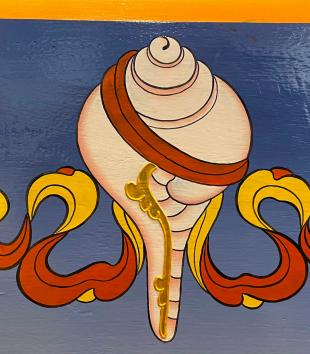 Flying Conches in the High-Altitude Oceans of the Himalayas: Displaced Objects and Multiscalar Relations in the Mountains of Sikkim
Flying Conches in the High-Altitude Oceans of the Himalayas: Displaced Objects and Multiscalar Relations in the Mountains of Sikkim
Conch shells frequently appear as objects in religiously inspired artwork and shrines in Sikkim, west India. Their frequent appearance in material culture and invocation in Classical Tibetan-language literary culture is indicative of a rich repository of connections. This essay explores some of their many resonances, in particular their significance as indicators of ecological change in the Himalayas.
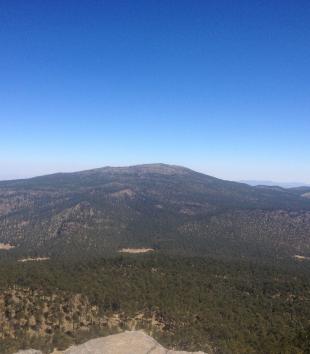 The Ritual Ascent at Mount Tlaloc, Mexico
The Ritual Ascent at Mount Tlaloc, Mexico
Bridging ecology, ethnohistory, linguistics, and art historical inquiry, this article argues that the various forms of vegetation encountered along the slope of Mount Tlaloc during the ascension of the tlahtoque were of ritual significance within Nahua worldview.
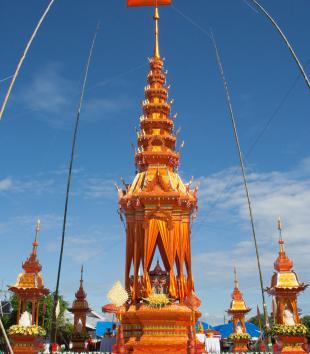 Gold Palaces: Merit, Beauty, and Perfection in the Cremation Structures of Monks in Northern Thailand
Gold Palaces: Merit, Beauty, and Perfection in the Cremation Structures of Monks in Northern Thailand
Cremation structures serve the utilitarian purpose of incinerating a corpse to aid transition from life to death, but in contemporary practice in Northern Thailand, opulent, golden-colored cremation structures called prasat sop also create a stunning sight that give local viewers a deeper understanding of all sentient beings’ connection to death.
 Qoyllur rit’i: El señor de la Estrella de Nieve
Qoyllur rit’i: El señor de la Estrella de Nieve
En 2012 empecé a hacer un registro gráfico del peregrinaje que poco a poco se convirtió en un proyecto fotográfico. Al intentar comprender este mundo sincrético, la fotografía me permitió plasmar y narrar lo que veía.
 Qoyllur rit’i: The Lord of the Snow Star
Qoyllur rit’i: The Lord of the Snow Star
In 2012, I began to make a graphic record of the pilgrimage, which little by little evolved into a photographic project. In attempting to comprehend the syncretic world of the festival, photography allowed me to capture and narrate what I saw.
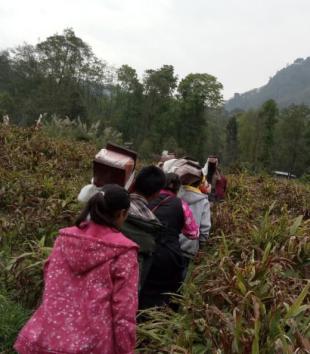 The Book as a Generative Agent: The Buddhist Canon as a Community Member in Book Procession Rituals of the Himalayas
The Book as a Generative Agent: The Buddhist Canon as a Community Member in Book Procession Rituals of the Himalayas
Known as the Bumkor, the books that make up the Bum are not just objects, but are generative, active agents that are capable of producing and renewing auspiciousness in the local human and nonhuman community that reside in the landscape.
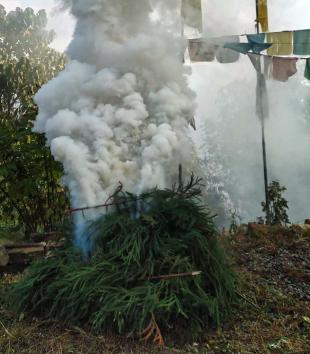 Purifying Multispecies Relations in the Valley of Abundance: The Riwo Sangchö Ritual as Environmental History and Ethics in Sikkim
Purifying Multispecies Relations in the Valley of Abundance: The Riwo Sangchö Ritual as Environmental History and Ethics in Sikkim
The Riwo Sangchö is a ritual exchange that facilitates smoky relations between humans and spirits resident in landscapes around the world.
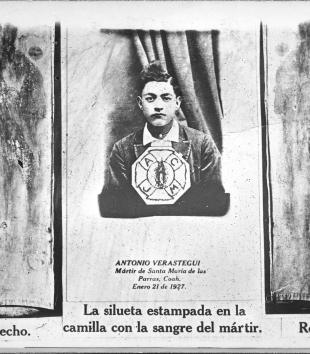 Photographic Postcard Commemorating Antonio Verástegui
Photographic Postcard Commemorating Antonio Verástegui
A postcard commemorating a young “martyr” of Mexico’s Cristero War named Antonio Verástegu engages the spectator in an act of witnessing that entails both religious and political consequences.
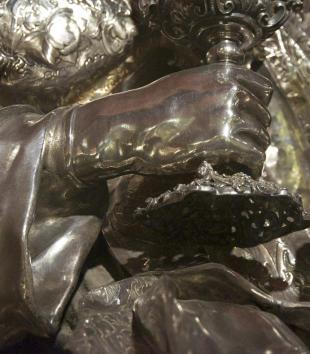 Colonial Materiality: Silver’s Alchemy of Trauma and Salvation
Colonial Materiality: Silver’s Alchemy of Trauma and Salvation
Embedded in power relations, coloniality, and matters of purification, early modern silver was a particularly generative site. Might its peculiar paradoxes be usefully thought in terms of a materiality of trauma?
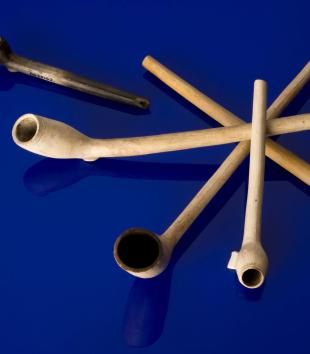 Material Technologies of Empire: The Tobacco Pipe in Early Modern Landscapes of Exchange in the Atlantic World
Material Technologies of Empire: The Tobacco Pipe in Early Modern Landscapes of Exchange in the Atlantic World
The look and shape, feel and function of the tobacco pipe footnote the transformational features of the early modern Atlantic world: landscapes of exchange.
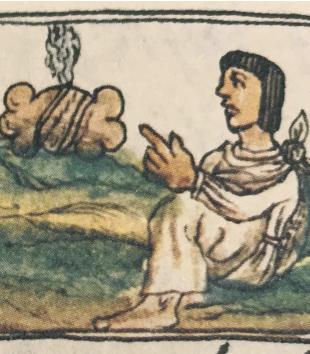 Locking Eyes with the Sun: Perception, Landscape, and the Fame of Greenstone in a Sixteenth-Century Nahuatl Narrative
Locking Eyes with the Sun: Perception, Landscape, and the Fame of Greenstone in a Sixteenth-Century Nahuatl Narrative
A narrative describing interactions between a human knower, sun, and precious stones enables a new interpretation of Nahua accounts of precious stones releasing vapors, while also providing greater insight into the nature of sensory experience in Nahua thought more generally.
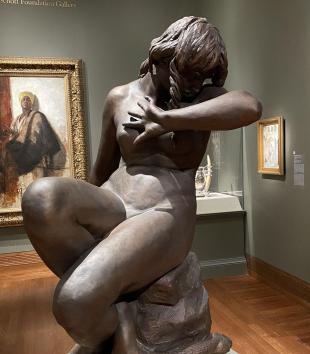 Moses Jacob Ezekiel, Eve Hearing the Voice
Moses Jacob Ezekiel, Eve Hearing the Voice
In 1876, Moses Jacob Ezekiel, the first Jewish American artist of international stature, sculpted the world’s first woman, to which he gave the title, Eve Hearing the Voice.
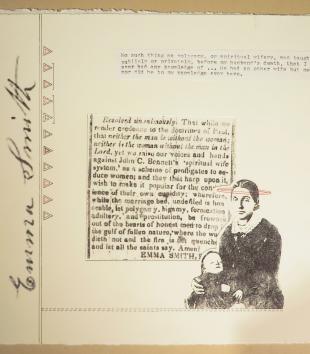 Art, Religious Memory, and Mormon Polygamy
Art, Religious Memory, and Mormon Polygamy
What happens when part of the religious history a person believes in turns out to be incorrect?
 Mural Paintings, Church of the Summer Residence of the Maronite Patriarch, Diman
Mural Paintings, Church of the Summer Residence of the Maronite Patriarch, Diman
Since its construction around the turn of the twentieth century, Our Lady of Diman has served as the summer residence of the Maronite Catholic Patriarch. The prestige of the building is everywhere apparent: in the inlaid marble floor, in the gold and blue panes of the stained-glass windows. The church’s most remarkable feature, however, is the ceiling over its nave, with frescoes completed in the late 1930s by celebrated Lebanese painter Saliba Douaihy (1913-1994).
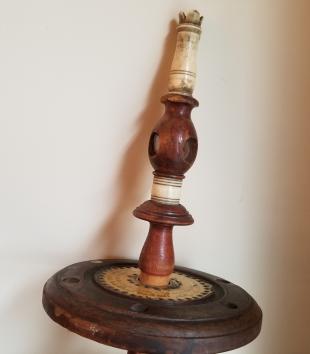 A Stick of Wood, a Tree of Life
A Stick of Wood, a Tree of Life
This Ets Chayim, a Tree of Life, is obsolete, redundant, out of time and out of place. It is detached both from the Torah scroll for which it was made, and from its mate that once served that scroll’s other end. It is not supposed to be here anymore—here, that is, in a transformed, glass-sheathed, twenty-first-century Lower East Side, where the traces of immigrant life have been erased, sanitized, and gathered into museums, or commodified as “atmosphere” for an urban playground. Perhaps the act of marking it—noting its persistence beyond obsolescence, shorn of the text to which it was once an auxiliary, bereft of the hands that once grasped it and the congregation that once stood as it was lifted up—is a minor act of resistance in itself.
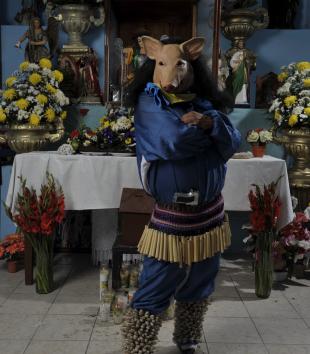 Fernando Brito and Héctor Parra, Judío
Fernando Brito and Héctor Parra, Judío
In Judío, photographer Fernando Brito attempts to find an ad-hoc visual representation for the Yoremem or Mayo Indians in his native state of Sinaloa, Mexico. This portrait pays tribute to the foundational value of the community’s ritual, which combines indigenous cosmology with seventeenth-century Jesuit influence, as crucial to its survival and cohesion.
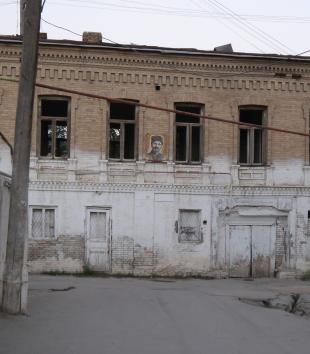 A Dying House in Samarkand’s Jewish Neighborhood
A Dying House in Samarkand’s Jewish Neighborhood
Pagiel Leviyev’s house is very sick. Built in Samarkand over a century ago, the structure was designed as a mansion for a wealthy mercantile family. Today, it stands as a crumbling reminder of the Jewish community’s long and complex history in this unexpected spot of the world.
This special joint issue is published with The Journal of Southern Religion (JSR). The journals issued a call for papers together in 2017 and are pleased to publish these four peer-reviewed articles, two editorial introductions, and one editorial reflection. In his editorial reflection, Bill Ferris considers his own history with southern religion and material culture. Jason Young and Louis P. Nelson offer introductions for the four articles, with additional reflection on the state of the field.
 Material and Visual Cultures of Religion in the American South
Material and Visual Cultures of Religion in the American South
Described by Flannery O’Connor as “Christ-haunted,” southern identity is and always has been shaped by religion. The still familiar sight of churches and hand-painted religious signs along highways and roads are powerful reminders of religion throughout the region. As the field of Southern Studies has evolved, so has our understanding of religion and its expression in material and visual culture in the region.